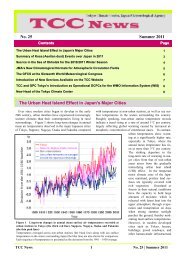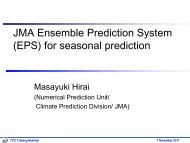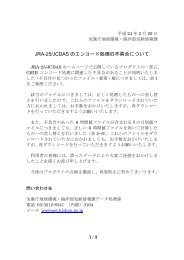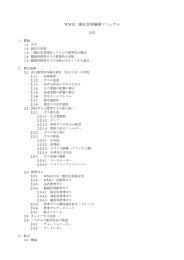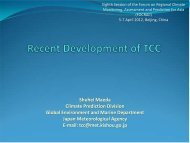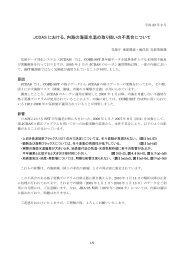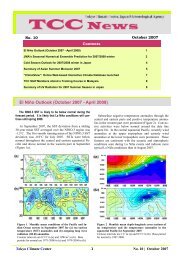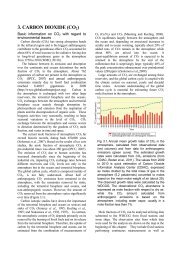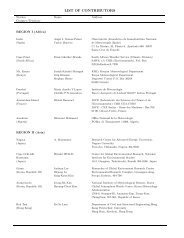TCC News No. 30
TCC News No. 30
TCC News No. 30
You also want an ePaper? Increase the reach of your titles
YUMPU automatically turns print PDFs into web optimized ePapers that Google loves.
Status of the Antarctic Ozone Hole in 2012<br />
The ozone hole was at its smallest since the 1990s.<br />
The Antarctic ozone hole in 2012 was the smallest in<br />
terms of its annual maximum area since the 1990s (see the<br />
upper right panel in Figure 38) according to JMA’s analysis<br />
based on data from National Aeronautics and Space<br />
Administration (NASA) satellites. Higher temperatures in<br />
the lower stratosphere contributed to the smaller coverage<br />
of the hole during Antarctic spring. However, the hole is<br />
still large compared to its size in the early 1980s, which is<br />
consistent with the high levels of ozone-depleting substances<br />
in the Antarctic atmosphere.<br />
Over the last <strong>30</strong> years, the Antarctic ozone hole has<br />
appeared every year in Austral spring with a peak in September<br />
or early October. In 2012, it formed in mid-August<br />
and expanded rapidly from late August to early September,<br />
reaching its maximum size for the year on 22 September.<br />
At this time it covered 20.8 million square kilo-<br />
Any comments or inquiry on this newsletter and/or the <strong>TCC</strong><br />
website would be much appreciated. Please e-mail to<br />
tcc@met.kishou.go.jp.<br />
(Editors: Teruko Manabe, Ryuji Yamada and Kenji Yoshida)<br />
meters (upper left panel), which is 1.5 times the area of<br />
the Antarctic Continent. The gray shading in the bottom<br />
panels indicates the progress of the hole’s development<br />
and intensity this year.<br />
The ozone layer acts as a shield against ultraviolet radiation,<br />
which can cause skin cancer. The ozone hole first<br />
appeared in the early 1980s and reached its maximum size<br />
of 29.6 million square kilometers in 2000. Although this<br />
year’s was the smallest since the 1990s, the amount of<br />
ozone in the Antarctic region is expected to return to<br />
pre-1980 levels in the late 21st century according to<br />
WMO/UNEP Scientific Assessment of Ozone Depletion:<br />
2010. Close observation of the ozone layer on a global<br />
scale (including that over the Antarctic region) remains<br />
important.<br />
(Hiroaki Naoe, Ozone Layer Monitoring Office,<br />
Atmospheric Environment Division)<br />
Figure 38<br />
Antarctic ozone hole characteristics<br />
Upper left: Time-series representation of the daily ozone-hole area for 2012 (red line) and the 2002–2011 average<br />
(black line). The blue shading area represents the range of daily minima and daily maxima over the past 10 years.<br />
Upper right: Interannual variability in the annual maximum ozone-hole area. Bottom: Snapshots of total column ozone<br />
distribution on selected days in 2012; the ozone hole is shown in gray. These panels are based on data from NASA satellite<br />
sensors of the total ozone mapping spectrometer (TOMS) and ozone monitoring instrument (OMI).<br />
Tokyo Climate Center (<strong>TCC</strong>), Climate Prediction Division, JMA<br />
Address: 1-3-4 Otemachi, Chiyoda-ku, Tokyo 100-8122, Japan<br />
<strong>TCC</strong> Website: http://ds.data.jma.go.jp/tcc/tcc/index.html<br />
<strong>TCC</strong> <strong>News</strong> 14 <strong>No</strong>. <strong>30</strong> | Autumn 2012



